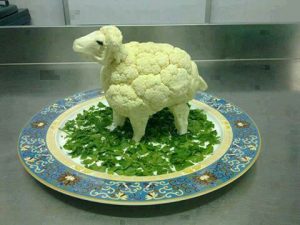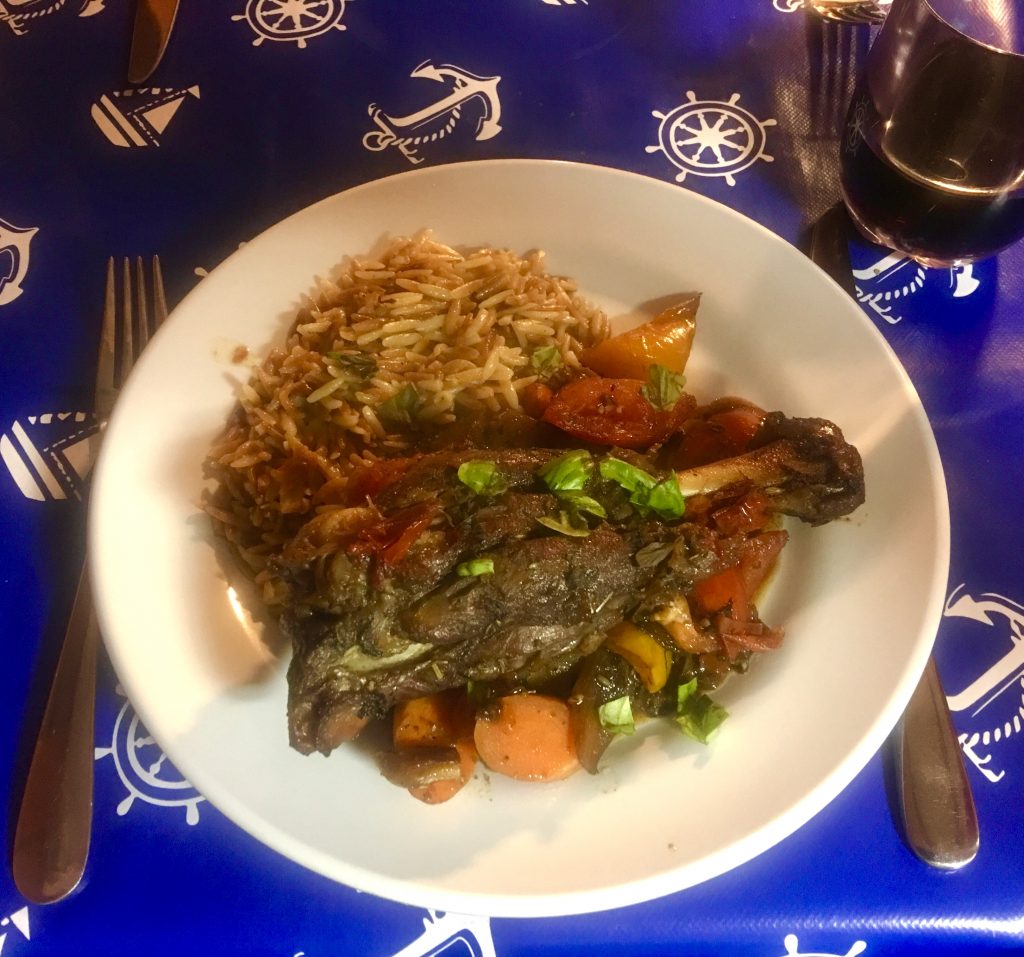Sailing and sailboats were not a part of my upbringing. In 1963, at the age of 11, I moved with my family to a small farm we leased in western South Dakota—just east of the northern Black Hills.
Before I go any further, I should mention that this blog is about the dinner I made to commemorate my and Julie’s 30th wedding anniversary on September 5th.

I’ll get to the recipe, but thought a little background and history was appropriate to shed light on my choice of ingredients.
Moving right along.
We started out with sheep to generate cash. Sheep produce two paying crops a year: wool in the spring and lambs in the fall. Sheep are also more labor intensive but my dad had my younger brother and me to help with the work. Among other chores, Buck and I were given responsibility for the bum lambs.
Bum lambs are either orphaned or abandoned by feckless mothers, or are twins or triplets that require more milk than their mas could produce. We fed and cared for the lambs—20-30 every year from a flock of 200 ewes—then got the profits from their sale in the fall.
As a family, we were immersed in the sheep-raising culture. We participated in joint shearings where multiple sheep farmers brought their flocks together in the spring to harvest the wool from the adult sheep and dock and castrate lambs. Buck and I took turns stomping fleeces into the 20 foot burlap bags suspended from a gantry. We were often paid by the shearers and other ranchers to wear their leather boots and shoes in the bags so they got oiled up by the lanolin in the wool. Nickel a pair, as I recall.

They actually brought extra pairs for us to wear. At the end of the day we took long showers to get the sheep smell off our skin and hair, and to remove the sheep ticks that inevitably sought refuge on live skin after being removed from the sheep. All these years later I can still feel the little bastards crawling on me.
We joined the Horse Creek Sheep Club—a local 4-H chapter focused on sheep—and collected ribbons and trophies showing our prize Suffolk and Hampshire lambs at the Butte County fair. We also ate a lot of mutton and lamb. My mother was not an adventuresome cook, but somehow she made even the rankest old ewe meat into a glorious stew. (Ewe stew—I know there’s a joke in there.) I developed a taste for lamb in particular, and have transcribed that affinity into some very successful dishes over the years.
One thing I do not remember ever eating during our sheep-growing years is lamb shank. If it wasn’t in her Betty Crocker cookbook—the three-ring binder version—Mom didn’t make it. I suppose shanks could have been part of her stews, but it was never the star of a meal that I recall. A gorgeous shot of braised lamb shanks on the cover of Bon Appetit in the 1990s caught my eye and I made the recipe. Lamb shanks became one of my favorite meat dishes, and that’s what I served my bride for dinner 30 years on.
Now Julie has never been a fan of shanks, but she loves lamb. The first meal she ever cooked for me was a perfectly roasted leg of lamb pierced with shards of garlic, rosemary needles and slathered in Dijon mustard. Mmmm-mm. If I wasn’t in love with her already, that meal sealed the deal. Ironically, that lamb dinner was also the last meal she ever cooked for me. She promptly and happily relinquished the kitchen when we started living together. Now, anytime someone questions my dominance in our cooking arrangements, I just tell them that Julie uses the smoke alarm as a timer.
Julie’s lack of enthusiasm for lamb shanks is about texture. She doesn’t like having to deal with the bones and the gristle. She wrinkled her nose when I told her what I was making for our anniversary dinner, so I decided to reprise and refine a lamb shank recipe I cobbled together on a vacation in Provence several years ago.
We were visiting our condo neighbors and new friends John and Karen at the timeshare they had in Les Antibes. Julie and I already had a history at Les Antibes, and we compounded it exponentially with John and Karen. One day we visited the local farmers market where I passed a vendor who had a vat full of simmering lamb shanks (souris d’agneau). They looked and smelled vraiment incroyable, as the French would say. Rather than buy the shanks already prepared, I passed by and lingered at the shank stand several times to savor the smells and try to identify the ingredients. It wasn’t hard, of course—we were in Provence. Provençals have a particular selection of herbs and spices they cook with: herbs de Provence. Sorting out the particular blend for the lamb was the real challenge. I wrote up a list of identifiable herbs and other ingredients I could make out from my lurking and translated them into French. I then dispensed Julie, John and Karen to fill that list from among the long tables of herbs, spices and vegetables in the market. In short order we found everything we needed at that market except the main ingredient: lamb shanks. So we went off to a supermarche our hosts knew and found lamb shanks, some promising Cotes du Rhone red wine and an intriguing-looking bottle of Cles des Ducs Armagnac.
I braised the shanks in the herbs, veggies and broth and wine for several hours and served it with garlic mashed potatoes. Everybody raved about the meal, even Julie, but I was never able to get her excited about lamb shanks again.
We’ve had various lamb shank meals since Les Antibes despite Julie’s lack of enthusiasm for them. So when I announced we were having lamb shanks for dinner the other night and got the wrinkled nose again, I remembered she seemed to like the Provençal recipe I’d made. I hadn’t recorded what I did that day in France, so I started surfing the Internet for lamb shanks Provençal. We were in Little Tub harbor in Tobermory with decent wi-fi. Up popped a promising recipe from PBS that was served with ratatouille, another classic Provençal dish. The combination sounded like a win-win that would offer my finicky bride-30-years-on a substantial vegetable alternative if she didn’t want to deal with the shank. I also decided to serve it up with toasted orzo and found a suitable lemon-tinged recipe from Martha Stewart.

As usual, I took some liberties with the recipes. In particular, I sliced some fresh fennel into the braise and the ratatouille for that little anise-y kick that I love with lamb. It was doubly successful because the anise paired well with the spicey California Syrah I had on hand. Much to my surprise, Julie loved the entire meal—especially the lamb shank! In fact she couldn’t get enough of it. She declared it was one of the best meals I’ve ever made.
It’s nice to know that after 30 years, I can still please and surprise my bride.
The recipes include my substitutions and modifications.
September 5, 2017 Tobermory Ontario 45°15.371’N 81°39.742’W 1624.7 Nautical Miles

